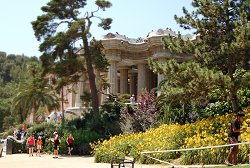 The
Park Güell is one of the wonderworks by Antoni Gaudi, where he most
perfectly succeeded in adapting architecture to nature and merged both
into a harmonious whole. The
Park Güell is one of the wonderworks by Antoni Gaudi, where he most
perfectly succeeded in adapting architecture to nature and merged both
into a harmonious whole.
The 17.18 ha large park was a commissioned work for the industralist
Eusebi Güell, who was a lifelong close friend and patron of Gaudi.
Inspired by the English Garden city movement, the park was originally planned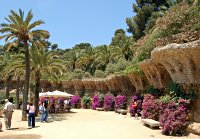 as
a garden city with approximately 60 villas. Gaudi worked on this
project from 1900 to 1914 but, however, could not complete it due to missing
funds. Eventually only two villas were built. One of them Gaudi bought
in 1906 for his family and his father and inhabited it up to his death.
Today it is home to the Gaudi museum. Since 1923 the park has been in urban
possession and freely accessible to the public. as
a garden city with approximately 60 villas. Gaudi worked on this
project from 1900 to 1914 but, however, could not complete it due to missing
funds. Eventually only two villas were built. One of them Gaudi bought
in 1906 for his family and his father and inhabited it up to his death.
Today it is home to the Gaudi museum. Since 1923 the park has been in urban
possession and freely accessible to the public.

With this masterpiece Gaudi turned the almost naked sunburned Montana
Pelada (bald mountain) into a Garden of Eden with luxuriant vegetation
and ingeniously designed architectural elements, which make the hilly Terrain
easily accessible, give plentiful shade and afford spectacular views
of the city. Colourful mosaics, arcades
with diagonal buttresses, nventively
shaped retaining walls, viaducts
and terraces fit, with their natural forms, organically into the terrain
and convey the impression of absolute naturalness. It is a place
of peace, harmony and calm. The necessary materials Gaudi found on
the site itself, and for the many mosaics he used wastes from nearby ceramic
factories.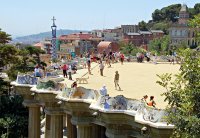
The heart of the park is the central
terrace on top of the hall
of the hundred columns (actually only 84), a work of art in itself. It is surrounded by a serpentine shaped bench which is decorated all over
with marvellous mosaics. This terrace is undoubtedly one
of the most spectacular vantage points of Barcelona and a quite popular
place for cultural meetings, musicians and painters.
Since 1984 the Park Güell has been on the UNESCO World Heritage
list. |
Mosaics
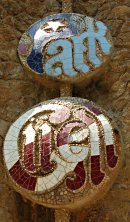
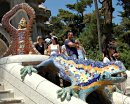

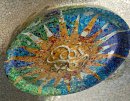 |

